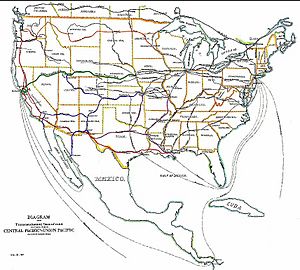Transcontinental railroad facts for kids
A transcontinental railroad is like a super-long train track that goes all the way across a huge piece of land, like a continent! Imagine a train journey that starts on one side of a country and ends on the other, maybe even touching two different oceans. That's what a transcontinental railroad does. It's a continuous path for trains, connecting far-apart places. These amazing railway networks can be built by one company or by many working together.
Contents
Connecting Continents by Rail
A transcontinental railroad connects different parts of a continent. It links terminals at oceans or borders. This means you can travel by train from one side of a country to the other. These railroads are a continuous path of tracks. They allow trains to move goods and people over very long distances.
Why Build Such Long Tracks?
People wanted transcontinental railroads for many reasons. They helped countries grow and connect.
- Faster Travel: Before railroads, crossing a continent took months. Trains made it much faster.
- Moving Goods: Farmers could send crops to cities. Factories could ship products across the country. This helped businesses grow.
- New Settlements: Railroads made it easier for people to move to new areas. Towns often grew up along the tracks.
- National Unity: Connecting distant regions helped bring countries together. It made communication and trade easier.
- Military Use: Governments could move soldiers and supplies quickly if needed.
America's First Great Railway
The most famous transcontinental railroad in the United States was finished in 1869. It connected the eastern and western parts of the country. Before this, traveling west was very hard and dangerous. People used wagons or sailed around South America.
Building the Pacific Railroad
The idea for this railroad started many years before it was built. People dreamed of a fast way to reach California. Two companies worked on it:
- The Central Pacific Railroad started building from Sacramento, California, heading east.
- The Union Pacific Railroad started building from Omaha, Nebraska, heading west.
Thousands of workers built the tracks. Many were immigrants from China and Ireland. They faced huge challenges. They had to blast through mountains and cross deserts. It was very hard and dangerous work.
The Golden Spike
On May 10, 1869, the two railway lines met. This happened at Promontory Summit, Utah. A special "Golden Spike" was driven into the ground. This marked the completion of the first transcontinental railroad in the U.S. It was a huge moment in American history.
How Railroads Changed the World
Transcontinental railroads had a massive impact.
- Economic Growth: They boosted trade and industry. New markets opened up for goods.
- Population Growth: More people moved west. Cities and towns grew rapidly along the railway lines.
- Time Zones: To make train schedules work, standard time zones were created. This changed how people thought about time.
- Communication: Mail and news could travel much faster. This helped connect people across vast distances.
Other Amazing Transcontinental Lines
Many other countries also built transcontinental railroads.
- Canada: The Canadian Pacific Railway was finished in 1885. It connected eastern Canada to the Pacific coast. This helped unite the young country.
- Russia: The Trans-Siberian Railway is one of the longest in the world. It crosses all of Russia, from Moscow to the Pacific Ocean. It was completed in the early 1900s.
- Australia: Australia has several transcontinental lines. One connects Sydney on the east coast to Perth on the west coast.
These incredible railway lines changed how people traveled, traded, and lived. They truly connected continents.
Images for kids
-
Lord Strathcona driving the "Last Spike" of Canada's first transcontinental railroad, the Canadian Pacific Railway, in 1885
See also
 In Spanish: Ferrocarril transcontinental para niños
In Spanish: Ferrocarril transcontinental para niños



